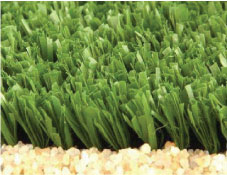|
With today’s changing environment, water supply is at an all time low. The demand for synthetic grass surfaces has increased dramatically. That’s why at Imaginationplay we are committed in providing the highest quality artificial grass surfaces for both domestic and commercial industries.
Imaginationplay offers a large variety of artificial grass for all purposes. With the latest water restrictions and water conservation, Imaginationplay sought a perfect solution to resolve that old dried lawn for residential, commercial properties, playground equipment and sports fields into show case display.
We pride ourselves on providing the most durable, long lasting and
realistic grass surfaces to suit any area. Sport’s fields including golf, football, soccer and hockey fields as well as school playing areas and all domestic usage are some of the most common grass areas we provide our services.
Safety is of the highest priority when it comes to our products. That’s why we also have an extensive range of soft fall surfacing
additions to our artificial turf. SBR rubber mixed with Silica Sand and a closed Cell EVA base provides a soft fall grass surfacing complying to Australian Standards.
Before you begin any works, there are a couple of things to consider.
- Identify any problems with drainage? Usually we will try to maintain the drainage as it exists on the site. Is the area currently draining well and where is it draining to? If significant earth works are required will this affect the drainage? Should it be a concern the you should ask us to have a look and asses the drainage in the area?
- Assess the proposed finished level of the grass in relation to the surrounding area. For instance we will need to meet up with existing pathways, drain grates ECT. This may affect the excavation required. An allowance of 100mm must be given for the crushed rock base. Add to this an allowance for grass and rubber shock pads if applicable.
- All vegetation must be removed from site before the base is laid.
- Consider all services in the immediate area.
- Assess access for trucks and machinery. Note the access must be at least 3m wide with 4m clearance above with no tight corners to ensure large trucks can access the site. If unsure take a lot of photos of problem areas and show us. Limiting the size of trucks and machinery that can access the site can dramatically increase costs of the project.
Why the base is so important!
- The base is the most important part of your project.
- We use a 100mm thick base not a 75mm base which is the industry standard
- The surface is finished with a crusher dust to fill any imperfections a step that many companies do not bother with.
- We subcontract our base preparation for large jobs (over 1000 Sqm) to Bass Earth a professional earth stabilizing and base preparation company. Bass earth did the earth works at the recent Commonwealth Games in Melbourne. They were contracted to start works on the running track a field sports surface only to cover the entire job with soil and grass for the Boxing Day test. After the test was over they removed the grass and continued with the games arena to completion.
- Bass Earth use laser guided levelling systems which automatically guide the graders to ensure the base has perfect levels and even grade of fall for drainage. This laser guidance system costed $300,000 to purchase. The surface is proof rolled using a 6 ton roller same as is used in the construction of public roads (roller with large dimples to push into the surface to ensure compaction).
- Our quote is on average $10 a square meter higher than our competition for this the reasons listed above but when considering the cost of the job it is about 7-8% of the entire cost of the project. If your base fails you must pull up the entire job and start again. The grass will never go back down neatly so it too would need to be replaced. Effectively if your base fails not only must you commit to an entirely new surface you must also remove the old one. Costs are astronomical probably 1.3 times the initial quoted price. If your project costs $200,000 8% is $16,000 is very good value for money providing confidence in the quality of the base and ensuring that you won’t be left with a poor playing surface. All sports rely on an even playing surface should your base move you are compromising the safety of the people using the surface.
Our specifications and best selling points.
- Primarily there are two styles of grass; Monofilament and defribulated grass. Defribulated grass is an older style of grass and is manufactured using a wide tape of plastic approx 10mm wide which is split into thin strands to resemble the properties of real grass. Monofilament is a recent development in the artificial grass industry. Monofilament as the name suggests is a single blade of grass which is made of polyethylene making it very strong and will not split like other materials. The grass often comes in two color tones and resists reflection to provide the look of real grass. This style of grass is very difficult to distinguish from the real thing.
- 19mm ArtGrass this style is used for all hard court sports and is an alternative to Asphalt as a playing surface. It is very good for tennis and is also the preferred surface for hockey fields. This grass is a polypropylene defribulated grass and is filled with sand only to 95% of the depth of the grass giving a solid even playing surface designed to provide even and reliable rebound for hard court ball sports. Grass is rated lead free and Is UV stabilized.
- 50mm Real ArtGrass. This grass is made from polyethylene and is a monofilament construction. This style of grass is used for sports ovals including AFL, Soccer, Rugby and cricket. This grass is FIFA approved as a synthetic surface for Soccer. Other uses include landscape grass and softfall under playground equipment. The 50mm grass includes sand filler followed by rubber granule filler called CSPR. There is 23kg of sand per square meter and 12kg of rubber per square meter. As sand is twice as heavy as rubber the volumes of each included per square meter is equal. The rubber filler gives a natural feel and has exceptional shock resistance which is why we prefer to include this style of grass for field sports and under playground equipment. The grass can be considered a play area in its own right as it has texture and feel comparable to real grass. A few experienced suppliers sell monofilament grass in Australia however ours has a distinct advantage, it includes a central spine which is designed to prevent the grass from laying down see detail below.

- All fibres used in ArtGrass products are made by Ten Cate the world leader in synthetic yarn fibres see their website for more details. An artificial grass is only as good as the fibre that it is stitched with. Ten Cate has proven that its materials have exceptional life span and can withstand all weather conditions from hot high UV summers to cold frozen winters. This material is the best available.
Line markings and edge finish techniques.
- Concrete edge footing installed to the same level as the crushed rock surface. The grass is then glued to the top and outer face of the concrete and soil is battered against the outside edge to conceal the grass edge. Width can vary depending on the customer’s requirements, usually around the size of standard concrete curbing.
- Treated timber edge which is installed the same way as the concrete edge but is usually one sleeper wide.
- Soil filled edge whereby the edge of the grass tapers down into the soil and is covered by a soil batter to the same level as the playing surface. This style is the cheapest and works well however won’t give a sharp defined edge as with the techniques above.
- Pegged to the crushed rock base. This style can work well were space is limited and above techniques are not applicable. Usually used against buildings or walls. The grass surface runs up to the building or wall and is pegged down to the rock base before filler is applied to the surface. Note that it is possible to pull it up if a concerted effort is made however with 35kg of weight per square meter of filler is enough to prevent most attempts and disturbing the surface. It is rare that a surface is damaged in this way.
Accessories
Accessories are available to complement any sport. We use Truline as our sporting equipment supplier accredited equipment for all sports are available; see their website for the range available on www.trulineaustralia.com.au
Application: Landscape, Football, Multisport, Playground, Baseball, Rugby and all other outdoor activities.
Fibre: Polyethylene 12800 Dtex Monofilament fibre.
Colours: Double colour of peak green and emerald green.
Comments: UV stabilized, looks natural with good softness. Wear and skin burning resistance with strong stability of muscular joints.

Application:Tennis, Running, Basketball, Hockey & hard court sport’s
Fibre: Polypropylene (PP)
Colour's: One tone green.
Comments: UV stabilized, protects joints and reduces hard impact from player’s. Precision repetitive rebound from most ball sports.

Playground Safety Surface Test Report
for
ImaginationPlay
EVA Impact Surface Tile (40mm) under
Sand-filled Artificial Grass (40mm)
School of Mechanical Engineering
The University of Adelaide
1.0 Executive Summary
ImaginationPlay supply an artificial grass playground under surfacing product that consists of a 40mm layer of EVA foam
covered by a surface layer of sand-filled artificial grass (pile height: 40mm). Tests were conducted on the impact
absorption properties of this under surfacing product according to the impact test requirements of the Australian
Standard: AS4422:1996, when assembled together in the manner specified by the manufacturer. The impact test
result for the product sample is listed in Table 1 below.
TABLE 1 = Critical Fall Height for the product configuration tested.
Product Combination (Nominal Combined Thickness)
EVA Impact Surface Tile (40mm) under
Sand-filled Artificial Grass (40mm)
Critical Fall Height (m) = 1.6m
2.0 Introduction
The impact absorption properties of a 40mm layer of EVA foam material when covered by a layer of sand-filled
artificial grass (supplied by ImaginationPlay) was measured according to the impact test requirements specified
by the Australian Standard AS/NZS 4422:1996. The base-layer of EVA foam consisted of two individual 20mm
layers bonded together with adhesive. The layer of artificial grass (with a pile height of 40mm) rested
(un bonded) onto the EVA foam surface. A 14kg bag of sand (supplied by the manufacturer) was distributed
evenly over the area of the test piece, of size: 1m × 1m. The approximate depth of the sand in the pile of the
artificial grass was between 8-12 mm.
The testing involved dropping a 5 kg anatomically-shaped aluminum head form from specified heights and
measuring the deceleration of the head form as it strikes the test samples. The severity of the impact is measured
in terms of the Head Injury Criterion (HIC).
The Australian Standard AS/NZS 4422:1996 concentrates on a method for measurement of HIC, which indicates
the deceleration impact on the brain. It is does not indicate injury potential to other parts of the body. The HIC
values set in the standard are those, which, if exceeded, are likely to result in injury to the brain. It should be
noted that although the standard stipulates that a HIC value of 1000 (or a deceleration value of 200 g) will
determine the critical artificial grass fall height, this does not have widespread agreement. Common sense should always be
used in the interpretation and implementation of the results.
3.0 Referenced Documents
The documents that are pertinent to this report are:
• Australian Standard AS/NZS 4422:1996, “Playground surfacing - Specifications, requirements and test
method”.
• Australian Standard AS 2512.1:1996, “Methods of testing protective helmets”.
• International Standards Organization ISO 6487, “Road vehicles-measurement techniques in impact tests -
Instrumentation”.
4.0 Equipment and Procedure
The equipment used in the experimental testing is shown in Figure 1.
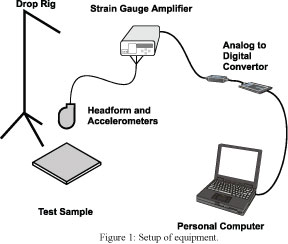
The equipment that was used to perform the impact testing is outlined below:
Drop Rig: The testing drop rig is a portable stand that is used to raise the head form. A pin is
released which permits the head form to fall unguided onto the artificial grass sample. The height
to which the head form is raised is measured with a vertical measuring tape between
the upper surface of the sample and the lowest point of the hanging head form.
Headform: The headform is made from aluminium and has an anatomical shape that complies
with the J-Type headform from AS 2512.1. It has a mass of 5.1kg. A tri-axial
accelerometer (Endevco 7268C-2000) is mounted at the centre of gravity of the
headform. The frequency range of the accelerometers is from 0-1000Hz. This
complies with channel class 1000 of ISO 6487. A cable connects the tri-axial
accelerometer to the strain gauge amplifiers.
Strain Gauge Amplifiers: The 3-channel Endevco Model 136 DC strain gauge amplifier is configured for fullbridge
circuit configurations. High precision balancing resistors are used to convert
the half-bridge accelerometers into a full-bridge circuit. Anti-aliasing filters (at
10kHz) are used for each channel.
Recording Equipment: The output from the strain gauge amplifiers is connected to an analog to digital (A/D)
converter board inside a notebook portable computer. The A/D board samples at
20.0kHz. The collection of data is triggered automatically based on the starting point
of an impact event as determined from the constant monitoring of a selected channel
value. The data acquisition procedure has a pre-trigger capability, such that the data is
collected over a time period spanning from just before to just after the impact to the artificial grass. A
sine wave at 200Hz is supplied to one of the A/D channels to provide a check that the
sampling rate is accurate.
Product Sample: The EVA foam under surfacing material was supplied in the form of two separate
20mm layers of EVA foam tiles pre-bonded together by the manufacturer. The
interlocking edges of the different tile layers were positioned so that these did not
correspond between the different layers. Overall, the tile pieces in each layer were
glued together (by the manufacturer), with a total size of 1m × 1m. This was
positioned flat against a concrete floor. The layer of artificial grass (with a pile height
of 40mm) rested (un bonded) onto the EVA foam surface.
All testing was conducted at the Thebarton Campus of the University of Adelaide in a laboratory environment
The testing method follows the Australian Standard AS/NZS 4422:1996. In general terms, the artificial grass sample to be
tested was placed on a concrete floor beneath the drop testing rig, the J-type headform was released from various
heights and the deceleration of the headform was measured as it struck the test sample. The critical fall height is
determined as the height when the Head Injury Criteria (HIC) equals 1000. The Head Injury Criteria is
calculated as:
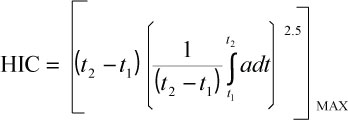
where a = the dimensionless ratio of the deceleration experienced by the headform to the deceleration due to
gravity (in g).
t2 , t1 = instant of time during the impact, chosen such that HIC is maximized, where t2 > t1.
The critical fall height is the height at which the HIC equals 1000 (or deceleration equals 200 g), rounded down
to the nearest 10cm, as specified in AS/NZS 4422:1996.
The artificial grass test procedure is listed below:
1. Prior to testing, the manufacturer’s calibration values for the tri-axial accelerometer are checked by aligning
each axis in a vertical direction so that a voltage measurement can be obtained for positive and negative
accelerations due to gravity.
2. The acceleration measurement obtained using the instrumented headform is verified by dropping it onto a
standard rubber mat, both before and after testing, to ensure consistency and accuracy of data measurement.
3. The artificial grass test sample is placed beneath the headform.
4. The headform is raised and held in position. The vertical height between the artificial grass test sample and the lowest part
of the headform is measured with a vertical tape measure.
5. The headform is released and is allowed to fall unguided and strikes the test sample. The collection of data on
the A/D board is triggered based on the beginning of the impact event. Data is collected from just before to
just after the impact event.
6. The data is analyzed to determine the HIC value and Maximum g value for the drop test.
7. Steps 4-6 are then repeated so that a HIC value is obtained for each of four separate heights at the same
location on the test sample. The heights are selected so that HIC values are determined below 1000, close to
1000 and above 1000 (or alternatively, deceleration values below 200 g, close to 200 g and above 200 g).For some cases with the present product combinations, it was found necessary to drop the headform a number
of consecutive times at the test location prior to beginning the test measurements (see note below).
8. The headform impact location on the artificial grass test sample is moved to a new position. A total of three separate grass test
positions are selected for surfacing materials. The test positions for surfaces correspond with one
location in the middle of the tile surface, one location on the join between two tiles, and one location on the
join between all four tiles.
9. Graphs are drawn of the HIC values versus the drop height. The critical fall height is determined by the
height at which the HIC value equals 1000 (or deceleration equals 200 g), rounded down to the nearest 10cm.
The artificial grass samples were tested at the locations shown in the Test Sheets in the Appendix
Note: For this EVA foam product sample tested, the magnitudes of the impact results over the first twenty drops
(at any particular location) were found to be steadily increasing. Since the impact performance of the surfaces
during these initial drops were generally non-repeatable, it is deemed not appropriate to include these initial
results among those to be considered for the AS4422:1996 standard. They do not provide a good indication of
the longer-term (repeatable) performances of the foam under surfacing surfaces, and are generally not included on
this basis. The impact test results measured after this initial “conditioning” process were found to be reasonably
consistent and repeatable within acceptable limits.
5.0 Results
5.1 General Comments:
The sample of the “EVA Impact Surface Tile (40mm) under Sand-filled Artificial Grass (40mm)” product tested
consists of a layer of sand-filled artificial grass (pile height: 40mm, sand in-fill height: 8-12mm) resting on a
40mm base-layer of EVA foam. With each consecutive impact onto the surface, the magnitudes of the impact
results measured are found to vary significantly. The variations of the impact magnitudes over twenty
consecutive impacts onto the surface at a single location (from a constant height of 1.6m) are detailed below in
Figure 2.
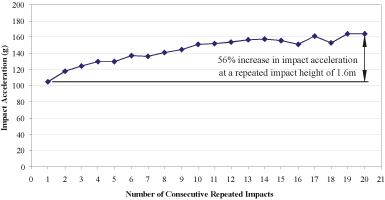
Figure 2: An example of the degradation of impact performance over 20 consecutive
headform drops (height: 1.6m) at the same location on the product sample.
When assessing the likely and foreseeable long-term impact attenuation performance of the “EVA Impact
Surface Tile (40mm) under Sand-filled Artificial Grass (40mm)” product according to Australian Standard
AS4422:1996, it is critical to consider the fact that the impact performance of the surface appears to degrades
considerably over the first twenty consecutive impacts at the same location (up to 56% as illustrated in Figure 2).
It is clear that the impact absorption characteristics of the surface change within these initial impacts onto the
surface, which are of a magnitude as required by the standard AS4422:1996. This is due to the combination of
displacement of sand material from the artificial grass pile at the impact location, and the degradation of the
impact absorption properties of the EVA foam underneath. Therefore, any assessment of the surface impact
absorption characteristics within the first number of drops on the surface (at any location) would not be
repeatable, and may not accurately or reasonably reflect the expected longer-term impact performance of the
surfacing.
To attain an acceptable level of reproducibility for the impact test results for measurement according to
AS4422:1996 , it was found necessary to simulate wear and ageing factors introduced by initial repeated impacts
on the product (caused by the impact compression of the EVA foam). Therefore, consecutive impacts (at least
twenty drops at each test location) were performed on the surface to produce results of acceptable repeatability
for measurement according to the standard. Within reason, the measured impact magnitudes appear to exhibit a
higher level of repeatability in terms of impact magnitude measurements after the first twenty consecutive drops
onto the surface (from 1.6m).
It is possible that the initial impact degradation represents an initial “wearing-in” period, where the performance
of the EVA foam tiles may degrade slightly over the initial period of use, especially in areas associated with high
impact traffic. However, the compressibility of the foam under high impact does suggest a shorter product life
span than more commonly used rubber under surfacing materials. The product should be either replaced (or retested
on-site) if there appears any sign of surface compression, wear or dimpling due to continuing high impacts,
to ensure continued performance of the surfacing near the critical fall height determined in these tests.
5.2 Test Results: “EVA Impact Surface Tile (40mm) under Sand-filled
Artificial Grass (40mm)”
According to the manufacturer, the “EVA Impact Surface Tile (40mm) under Sand-filled Artificial Grass
(40mm)” is described as follows:
“The top-coat surface layer consists of a layer of artificial grass (pile height: 40mm), in-filled with
sand (provided by the manufacturer) to an even depth of approximately 8-12mm. This rests unbonded
onto the 40mm thick base layer, which is made from two separate layers of 20mm interlocking EVA
foam tiles, bonded together.”
A photograph of the ‘EVA Impact Surface Tile (40mm) under Sand-filled Artificial Grass (40mm)’
under surfacing sample is shown below in Figure 2. The average combined thickness of the sample was measured
(on the day of testing) to be approximately 80mm.
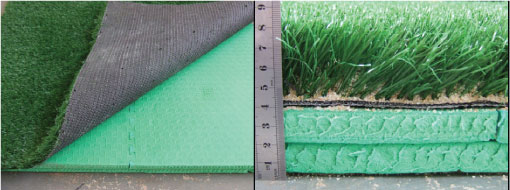
Figure 2a & 2b: Photographs of the “EVA Impact Surface Tile (40mm) under Sand-filled Artificial Grass
(40mm)” under surfacing test sample, showing (a) the top and bottom layers and (b) the
sample cross-section view.
The results from drop tests on the “EVA Impact Surface Tile (40mm) under Sand-filled Artificial Grass (40mm)”
sample are listed in Table 2.
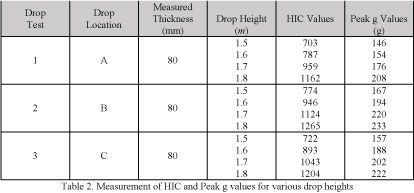
The results shown in Table 2 should be read in conjunction with the corresponding Test Sheet in Appendix A.
The critical fall height for the “EVA Impact Surface Tile (40mm) under Sand-filled Artificial Grass
(40mm)” under surfacing sample is 1.6m.
6.0 Conclusions
The testing of the ‘EVA Impact Surface Tile (40mm) under Sand-filled Artificial Grass (40mm)’ product
supplied by ImaginationPlay was undertaken according to the requirements of the Australian Standard: AS/NZS
4422:1996. The outcome of this testing resulted with the critical fall height (shown below in Table 3) for the
product listed.

APPENDIX A
The following 2 pages contain the test sheets for:
• EVA Impact Surface Tile (40mm) under Sand-filled Artificial Grass (40mm) (2 Pages)
Playground Safety Surface Test Report: “EVA Impact Surface Tile (40mm) under
Sand-filled Artificial Grass (40mm)”
Prepared by MECHTEST: 1st December 2008
for ImaginationPlay.
Introduction
AS/NZS 4422:1996 specifies testing requirements
to determine the critical fall height for playground
safety surfaces. The critical fall height is determined
by installing the safety surface as specified by the
manufacturer and determining the fall height at
which one of two safety criteria are exceeded; those
criteria are the Head Injury Criterion exceeding
1000, and the maximum acceleration due to the
impact exceeding 200 g. The critical fall height is
determined by dropping an instrumented headform
from various heights onto the artificial grass surface and measuring
the acceleration due to the impact. Heights tested
include those which produce measurements that
satisfy the relevant criterion and those which exceed
the relevant criterion.
It should be noted that the results reported here
relate specifically to the installation of the product
as specified by the manufacturer below and no
allowance has been made for incorrect installation,
ageing or degradation of the product. These results
should always be used in consultation with the
installing authority.
The critical fall height has been calculated relative
to a nominated piece of equipment and no
assumption has been made about the height of the
user above that equipment. The critical fall height is
quoted to the nearest 0.1 m, rounded down, as
specified in AS/NZS 4422:1996.
Product Tested
The artificial grass tested was supplied by
ImaginationPlay, of Hurstbridge, VIC and is
described as “EVA Impact Surface Tile (40mm)
under Sand-filled Artificial Grass (40mm)”. The
product sample consisted of an EVA foam tile
surfacing covered with artificial grass, with an
approximate average measured thickness of 80mm.
The test sample consisted of two layers of
interlocking EVA bonded together by the
manufacturer, underneath a layer of 40mm sand filled
artificial grass, resulting with a final test piece
of approximately 1m×1m in dimension. The testing
was conducted at the Thebarton Campus of the
University of Adelaide.
Installation and substrate
The product sample consisted of a single combined
test piece (of dimension 1m x 1m), resting flat
against the substrate, which was a concrete floor.
Testing
This product was tested to the requirements for
AS/NZS 4422:1996. The position of the test
locations on the product sample are shown in Figure
A1. Results at locations A,B & C are presented in
this report.
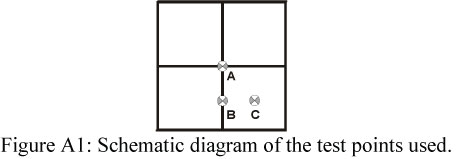
Conditions
Time: 11:30am
Air Temperature: 21°C
Surface Temperature: 21°C
Test Results:
The results for the “EVA Impact Surface Tile
(40mm) under Sand-filled Artificial Grass (40mm)”
product are displayed in Table A1 below:
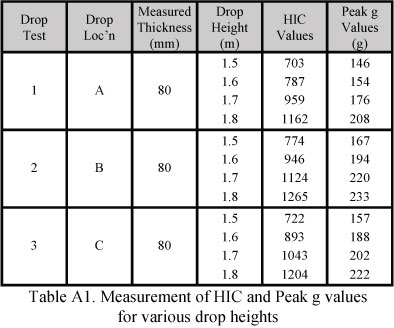
Critical fall height
The calculated critical fall height for this
product is 1.6m, based on the HIC & Acceleration
values measured at the height of 1.7m in the second
and third drop tests in Table A1 above.
Graphical results Figures A2 and A3 show how the HIC values and
the peak accelerations vary with the minimum fall
height.
Figure A4 shows an actual acceleration trace from
the tests; specifically from the second drop test at a
height of 1.7m.
References
AS/NZS 4422:1996, Playground surfacing -
Specifications, requirements and test method.
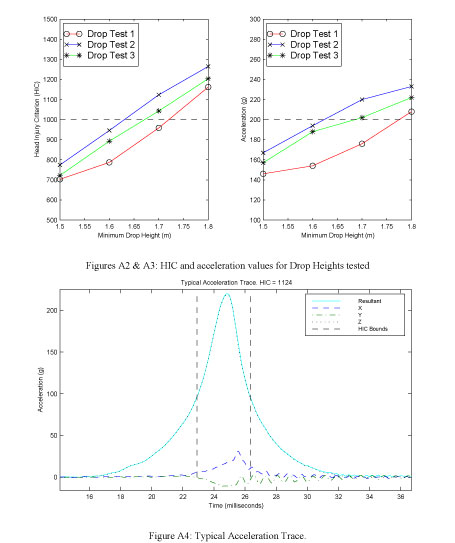
TEST CERTIFICATE
This is to certify that the product sample: “EVA Impact Surface Tile (40mm)
under Sand-filled Artificial Grass (40mm)” playground under surfacing, produced
by ImaginationPlay (as described in MechTest Report: MT0976c), has been
assessed according to the impact test procedure described in Australian/New
Zealand Standard: AS/NZS 4422:1996.
Tests were conducted on the impact absorption properties of this EVA foam tile
surfacing covered with artificial grass product, having an average combined total
thickness of 80 mm (measured on the day of testing). As a result, the following
specification was determined:
Product: “EVA Impact Surface Tile (40mm) under Sand-filled Artificial
Grass (40mm)”
Test Date: 1st December 2008
Critical fall height: 1.6m.
This page represents a summary of the major findings of the MechTest report: MT0976c. For
more detailed information regarding any aspect of the test procedure, the interpretation of test
results or the description details of the product tested, please refer to the MechTest Report:
MT0976c (in its entirety).
Please contact us for more information about artificial grass surfaces. Or would you like to return back to the home page or you can visit our playground equipment section?
|
